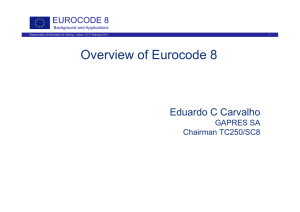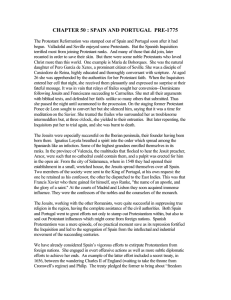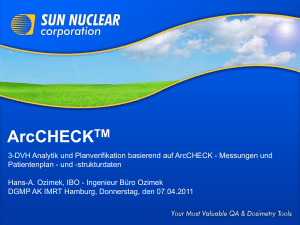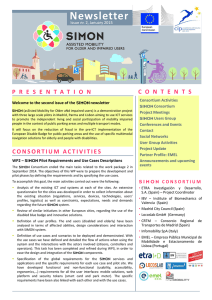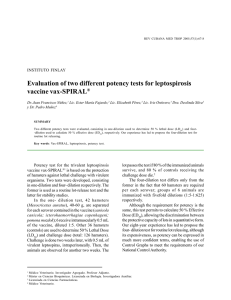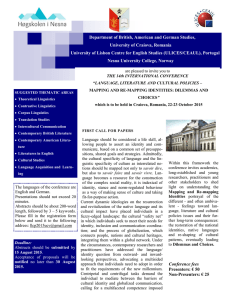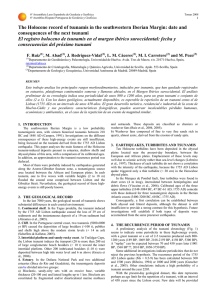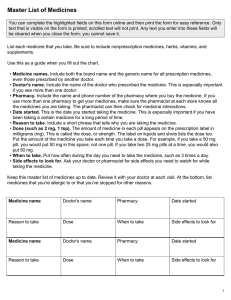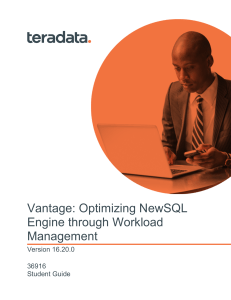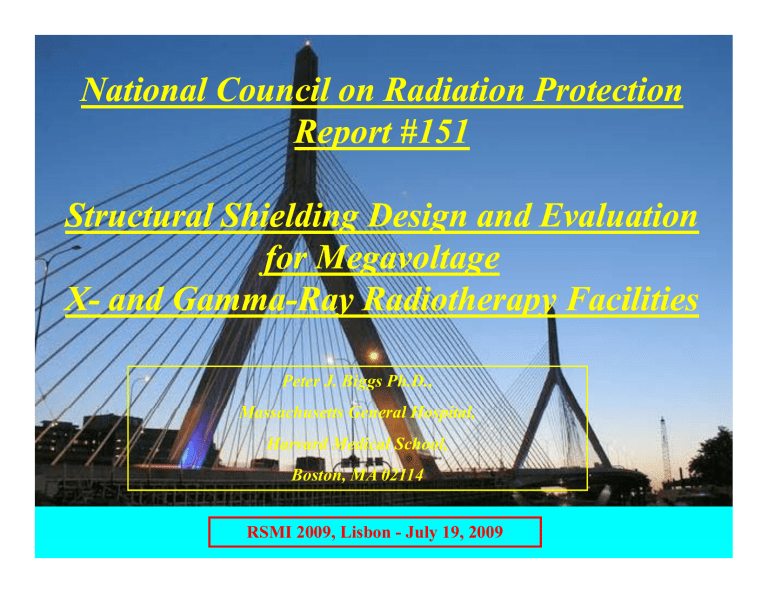
National Council on Radiation Protection Report #151 Structural Shielding Design and Evaluation for Megavoltage X- and Gamma Gamma--Ray Radiotherapy Facilities Peter J. Biggs Ph.D., M Massachusetts h tt General G l Hospital, H it l Harvard Medical School, Boston,, MA 02114 RSMI 2009, Lisbon - July 19, 2009 December D b 2005 RSMI 2009, Lisbon - July 19, 2009 Why Update NCRP 49? - NRCP 49 (1976)was a “medical physics” protection guideline - ~30 yrs between publication of NCRP 49 and 151 - NCRP 51 added additional high energy data (1977) – however, however this report was primarily for particle accelerators rather than medical linacs - NCRP 79 added dd d neutron methodology h d l andd data d (1984) RSMI 2009, Lisbon - July 19, 2009 Whyy Update p NCRP 49? - NCRP 51 was updated in 2003 (NCRP 144) – this initiated a request to produce a medical accelerator only document. document - The AAPM formed TG 57 ((J. Deye, y chair; R. Wu, cochair) in around 1997 to address this problem and this was later subsumed into NCRP Scientific committee 46-13 - Primarily, it was realized that existing reports did not reflect common practice in the field nor provide adequate methodology th d l andd up-to-date t d t data d t RSMI 2009, Lisbon - July 19, 2009 Rationale for Update (NCRP # 151) 1. 2. 3. 4. 5 5. 6. 7 7. Introduction of dual energy gy machines Upgrading facilities with laminated shielding New modalities oda t es and a d special spec a procedures p ocedu es Improved calculational methodology Additional and improved data Time-averaged dose rate considerations Special considerations RSMI 2009, Lisbon - July 19, 2009 1. Dual Energy gy Machines - Dual energy machines have been around for a long time, but became mainstream only when adopted by linear accelerators. - As a conservative approach, only high energy was originally considered for shielding (3D CRT), but with popularity of IMRT at 6MV, that has changed (Wl>>W Wp, Ws). RSMI 2009, Lisbon - July 19, 2009 1. Dual Energy Machines - How to split the workload between high and low energy and still be conservative - PJB rule of thumb: Assume 100% high energy for the primary and consider dual energies for out out-of of – plane leakage. The scatter and leakage adjacent to the primary is a toss-up - Change in workload vs. time: - Anecdote: For a 6/18 MV machine the energy gy use prior p to IMRT was 20%/80% (MU). With 28% IMRT patient load, the use was 70%/30% RSMI 2009, Lisbon - July 19, 2009 2. Whyy Laminated Shielding? g - A simple and, perhaps sole, solution to upgrading a vault holding a 60Co unit to a linear accelerator (note also, beamstopper vs. no beamstopper) - For low energies, since only photons are involved, calculation is straightforward. - For high energies, however, the issue of photoneutron production and subsequent capture gamma rays arises i andd this hi is i a complex l issue i RSMI 2009, Lisbon - July 19, 2009 3. New Modalities - Different modalities include: 1. 2. 3. Robotic arm machines (Cyberknife®) - no fixed isocenter - all barriers except ceiling are primary barriers - uses only 6 MV Tomotherapy py ((helical)) - “radiotherapy CT” - also uses only 6 MV - uses extra shielding g so the 0.1% rule does not apply pp y - uses a beam stopper Tomotherapy (serial) - device attached to conventional linac (MIMIC) - uses table indexer to simulate helical Rx - not in much use now RSMI 2009, Lisbon - July 19, 2009 3. Special Procedures (1) - W We have h come a long l way from f the th “4 fi field ld box” b ” treatment t t t arrangement, using many different procedures, including: 1 1. IMRT - usually only at 6 MV (Verhay et. al.) - Leakage workload >>primary, primary, scatter workload - Serial tomotherapy has highest relative leakage workload - For F hhelical li l tomotherapy, t th 100% off workload kl d - for conventional linacs, can be 70% or more of the workload - use factors may also be different RSMI 2009, Lisbon - July 19, 2009 3. Special Procedures (2) 2 2. St Stereotactic t ti radiosurgery/radiotherapy di / di th - use factors are substantially different from 3D CRT - high dose for radiosurgery, but long set-up times 3. TBI - P, L workload is greater than Rx dose - source of scatter radiation is not at the isocenter 4. IORT - dedicated facilities (not now in vogue) require lead/BPE barriers for retrofitting ORs - mobile linacs do not require a shielded room, except, perhaps, for a mobile bil lead l d barrier. b i Neutrons N have h been b source off discussion di i recently, l but appear not to be problematic RSMI 2009, Lisbon - July 19, 2009 4. Calculational Methodology - While much of the methodology for low energy photons has carried over, over albeit with improved data, there has been much research on high energy processes, including: 1. Laminated primary shielding (primarily empirical) 2. Refined calculations for neutron dose at the maze door (Wu-McGinley vs. vs Kersey) 3. Refined calculations for capture gamma rays at the end of a maze (McGinley) 4 Direct shielded doors for high energy linacs 4. RSMI 2009, Lisbon - July 19, 2009 5. Additional Data - Updated occupancy factors (in conjunction with NCRP #147) - P Primary i TVL continue TVLs i TVL1 andd TVLe practice i from f NCRP #51 – but values are slightly different - Leakage TVLs (90°) also now uses the same convention - Scatter fractions: 6 MV corrected and higher energies added - Scatter TVLs for energies other than 6 MV, plus lead. - Tabulated albedo factors for concrete as well as iron and lead RSMI 2009, Lisbon - July 19, 2009 6. Time Averaged Dose Rate vs. IDR - In response to practices in a few states in the US, in 2000, the NCRP issued a statement regarding the application of i t t instantaneous dose d rates t in i assessing i adequacy d off radiation di ti protection - The NCRP has never recommended dose limits for periods shorter than one month (only for the embryo-fetus in occupational p situations – NCRP Report p No. 116)) - The weekly exposure limit is conventionally taken to be 1/50 x the annual limit limit, namely 0.02 0 02 mSv/wk RSMI 2009, Lisbon - July 19, 2009 6. Time Averaged Dose Rate: NCRP - Conversion of annual limits to instantaneous dose rates leads to linking protective measures to the time characteristics of the machine (lower the dose rate?) - Specifically the use of a measured instantaneous dose rate at maximum xx-ray ray output does not represent the radiation environment of the facility - This problem is exacerbated by the introduction of flattening filter-free linacs where the dose rate can ↑ x5 - Need to consider the workload and use factor together g with the IDR when evaluating a barrier RSMI 2009, Lisbon - July 19, 2009 7. Special considerations - Skyshine: - this was included in NCRP #51, #51 but no experimental verification, for photons or neutrons, had been provided until now - side scattered photon radiation - G Groundshine ou ds e radiation d o - Activation - Ozone production RSMI 2009, Lisbon - July 19, 2009 Examples • NCRP #151 makes a point of using concrete examples to emphasize the calculational methodology • This was used in NCRP #49, except that there were only three calculations –P, L and S respectively • IIn contrast, the h examples l in i Chapter Ch 7 cover 53 pages out of a total of 157 pages (excluding appendices), roughly 1/3 - increased complexity of the calculations • Detailed calculations are given for 6 barriers as well as the maze door with consideration given to TADR and modifications for IMRT. IMRT There is also a section on calculations for a robotic arm machine RSMI 2009, Lisbon - July 19, 2009 Summary - NCRP #151 provides a significant improvement in the methodology and data needed by the shielding designer for a modern radiotherapy department - It covers all aspects of the calculational methodology and provides sufficient data for these calculations - However However, there are still some calculations that cannot easily be solved using a spreadsheet, that would benefit from further insight RSMI 2009, Lisbon - July 19, 2009 Thank you for your attention! Muito obrigado pela sua atenção! RSMI 2009, Lisbon - July 19, 2009
